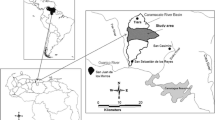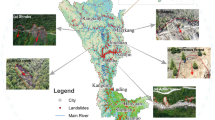Abstract
Landslides repeatedly cause damage in steep terrain and, therefore, the prediction of landslide susceptibility is important. In this context, comprehensive inventories with detailed information on shallow rainfall triggered landslides have been established in Switzerland. The present database includes information on more than 600 individual landslides. The data illustrate that slope inclination belongs to the most decisive parameters. Landslides occurred on slopes with inclinations from 20° to 50° with a majority on slopes of 35°–40°. The angles of internal friction of the landslide soil mostly range between 31° and 35°. Vegetation effects, particularly the existence of forest, are important reasons that slopes with inclinations of more than 35° were stable before the respective hazard events. This is supported by the fact that, in the majority of the event-inventories, landslide density is lower in forested areas than on open land. However, not only the presence of forest has an effect on slope stability but also its condition. Additionally, terrain morphology near the landslide seems to be relevant. A filtering procedure based on (i) soil mechanics and slope inclination, (ii) forest structure and (iii) terrain morphology explained more than 95% of 218 landslides in forested terrain. Additional case studies confirmed that forest structural characteristics do have an important influence on root reinforcement and shallow landslide susceptibility. For example a gap length of >20 m seems to be a critical threshold for landslide triggering. The study confirms that forest structure has—together with geomorphological and hydrological conditions—an important influence on shallow landslide susceptibility.
Access this chapter
Tax calculation will be finalised at checkout
Purchases are for personal use only
Similar content being viewed by others
References
Aleotti, P., Baldelli, P., Polloni, G.: Landsliding and flooding event triggered by heavy rains in the Tanaro basin (Italy). Proceedings of International Symposium Interpraevent 1996, vol. 1, pp. 435–446. Garmisch-Partenkirchen (1996)
Bezzola, G.R., Hegg, C.: Ereignisanalyse Hochwasser 2005, Teil 1—Prozesse, Schäden und erste Einordnung. Bundesamt für Umwelt BAFU, Eidg. Forschungsanstalt WSL. Umwelt-Wissen Nr. 0707. P. 215 (2007)
Frehner, M., Wasser, B., Schwitter, R.: Nachhaltigkeit und Erfolgskontrolle im Schutzwald. Wegleitung für Pflegemassnahmen in Wäldern mit Schutzfunktion, Vollzug Umwelt, Bundesamt für Umwelt, Wald und Landschaft, Bern, p. 564 (2005)
Graf, F., Frei, M., Böll, A.: Effects of vegetation on the angle of internal friction of a moraine. FOS-NOLA 82, 61–78 (2009)
Graf, F., Rickli, C.: Simple explanations for shallow landslides!? Geophysical Research Abstracts, vol. 18. EGU General Assembly (2016)
Guzzetti, F., Cesare, A.M., Cardinalia, M., Fioruccia, F., Santangeloa, M., Changc, K.-T.: Landslide inventory maps: New tools for an old problem. Earth Sci. Rev. 112(1–2), 42–66 (2012)
Hilker, N., Badoux, A., Hegg, C.: The Swiss flood and landslide damage database 1972-2007. Nat. Hazards Earth Syst. Sci. 9(3), 913–925 (2009)
Hürlimann, M., McArdell, B.W., Rickli, C.: Field and laboratory analysis of the runout characteristics of hillslope debris flows in Switzerland. Geomorphology 232, 20–32 (2015)
Kim, D., Im, S., Lee, C., Woo, C.: Modeling the contribution of trees to shallow landslide development in a steep, forested watershed. Ecol. Eng. 61, 658–668 (2013)
Mattli, J.: Quantifizierung der Wurzelverstärkung im Schutzwald, Bachelor Thesis. University of Applied Sciences, Berne, p. 79 (2014)
Moos, C.: How Does Forest Structure Affect Landslide Susceptibility? Statistical Prediction Models for Shallow Landslides Integrating Forest Structure, Master Thesis. ETH Zurich, p. 97 (2014)
Moos, C., Bebi, P., Graf, F., Mattli, J., Rickli, C., Schwarz, M.: How does forest structure affect root reinforcement and susceptibility to shallow landslides? Earth Surf. Proc. Land. (2016). https://doi.org/10.1002/esp.3887
Rickli, C. (ed.) (2001) Vegetationswirkungen und Rutschungen. Untersuchung zum Einfluss der Vegetation auf oberfächennahe Rutschprozesse anhand der Unwetterereignisse in Sachseln OW am 15. August 1997. Birmensdorf, Bern, Eidg. Forschungsanstalt WSL, Bundesamt für Umwelt, Wald und Landschaft, p. 97
Rickli, C., Zürcher, K., Frey, W., Lüscher, P.: Wirkungen des Waldes auf oberflächennahe Rutschprozesse. Schweiz. Z. Forstwes. 153(11), 437–445 (2002)
Rickli, C., Raetzo, H., McArdell, B., Presler, J.: Hanginstabilitäten.: In: Bezzola, G.R., Hegg, C. (eds.) Ereignisanalyse Hochwasser 2005. Teil 2—Analyse von Prozessen, Massnahmen und Gefahrengrundlagen. Bern, Bundesamt für Umwelt BAFU, Birmensdorf, Eidgenössische Forschungsanstalt WSL, pp. 97–116 (2008)
Rickli, C., Graf, F.: Effects of forests on shallow landslides—case studies in Switzerland. For. Snow Landscape Res. 82(1), 33–44 (2009)
Rickli, C., McArdell, B., Badoux, A., Loup, B.: Database shallow landslides and hillslope debris flows. [Abstract] In: Koboltschnig, G. (ed.) 13th Congress Interpraevent 2016. 30 May to 2 June 2016, Lucerne, Switzerland. Extended Abstracts. Living with natural risks, pp. 242–243. Luzern, International Research Society Interpraevent (2016)
Schwarz, M., Preti, F., Giadrossich, F., Lehmann, P., Or, D.: Quantifying the role of vegetation in slope stability: a case study in Tuscany (Italy). Ecol. Eng. 36(3), 285–291 (2010)
von Ruette, J., Papritz, A., Lehmann, P., Rickli, C., Or, D.: Spatial statistical modeling of shallow landslides—Validating predictions for different landslide inventories and rainfall events. Geomorphology 133, 11–22 (2011)
VSS: Identifikation der Lockergesteine – Labormethode mit Klassifikation nach USCS. Schweizer Norm SN 670 008a. Vereinigung Schweizerischer Strassenfachleute VSS, p. 16 (1997)
VSS: Geotechnische Erkundung und Untersuchung – Geotechnische Kenngrössen. Schweizer Norm SN 670 010. Vereinigung Schweizerischer Strassenfachleute VSS, p. 19 (2011)
Acknowledgements
We thank Josias Mattli for his contribution to the quantification of root reinforcement in the study area of St. Antönien. Furthermore, we acknowledge the project SOSTANAH of the Swiss National Research Programme 68 (grant number 406840_143122), and the EU project REVENUES FP7-PEOPLE-2012-IAPP (grant number 324,466) for supporting and funding our research.
Author information
Authors and Affiliations
Corresponding author
Editor information
Editors and Affiliations
Rights and permissions
Copyright information
© 2019 Springer International Publishing AG, part of Springer Nature
About this chapter
Cite this chapter
Rickli, C., Bebi, P., Graf, F., Moos, C. (2019). Shallow Landslides: Retrospective Analysis of the Protective Effects of Forest and Conclusions for Prediction. In: Wu, W. (eds) Recent Advances in Geotechnical Research. Springer Series in Geomechanics and Geoengineering. Springer, Cham. https://doi.org/10.1007/978-3-319-89671-7_15
Download citation
DOI: https://doi.org/10.1007/978-3-319-89671-7_15
Published:
Publisher Name: Springer, Cham
Print ISBN: 978-3-319-89670-0
Online ISBN: 978-3-319-89671-7
eBook Packages: EngineeringEngineering (R0)




